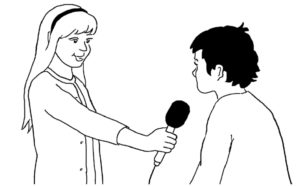Hint:
- A survey, as defined here, signifies interviews or polls, in which the answers to rather narrowly formulated questions (e. g. of 20 persons) are recorded and enumerated, such as the topic of TV consumption or resorts. In an interview, on the other hand, more open questions are asked, which lead to longer answers and reports.Interviews are mostly conducted with only one or a few persons because of their more elaborate analysis.
- The content of the interviews or surveys must be given. Generally, they are connected to current issues and topics discussed in class, for which people from one’s own culture should be consulted for their expert opinions. Examples: interviews with our parents and grandparents about the topic ‹leisure time then and now› or “childhood then and now”. – Phone interviews with friends and relatives about the topic “leisure activities here and in the country of origin”. – Interviews with various people about the topic of “rights and roles of girls and boys”.
- New possibilities and means for interviews and surveys which result from skype and cell phone technology, as well as e-mail, SMS and facebook for written surveys, absolutely should be used. These media allow students to interview people in the country of origin, and should definitely be used.
Procedure:
- Before conducting their own interviews and surveys, the students must be introduced to the topic and the “methodology”. The instructor should most likely be able to tie into students‘ pertinent experiences in regular classroom instruction (to be verified by polling the students or discussions with the teachers of mainstream education classes).
- As a possible introduction, the instructor models a practical example by asking a student about everyday themes and may deliberately pose good and less suitable questions. This may already be recorded with a recording device or a cell phone, so that the students can replay and review the questions and answers one more time.
- This experience is then analyzed and discussed and serves as an opportunity to develop the criteria for a good survey or interview. The students will have to observe these criteria in conducting their own surveys and interviews.
- The following steps are compiled in the conception of a survey:
Steps in the conception of a survey
- Determine the goals of the survey (what do we want to find out?).
- Find appropriate questions (two types of questions to differentiate):
- Decisional questions: answer possibilities are dictated (thus easier to document and analyze). Example: “Do you prefer to speak German or English?”. This type is characteristic for surveys.
- Open questions: this type allows for several and longer answers. This generates a broader and more exciting spectrum of information, but its analysis is more challenging. Example: “In your view, what should we learn in school?”. This type is frequently used for interviews.

- Consider already how the answers should be evaluated (counting, summarizing, commenting, etc.). This definitely requires the instructors advice.
- Also consider and clarify the form of the final presentation.
- Determine, how and where the questions and answers are administered (audio recording with recording device, cell phone, etc.; written summary). If the survey is conducted in pairs, student 1 can ask the questions, which student 2 records and documents.
- Consider an appropriate place for the survey (no distractions, no noise).
- Find appropriate people for the survey, inform them about the purpose and context of the survey, and ask for their participation.
- Conduct a trial run with 2–3 people, tweak questions if necessary.
- Implement the survey with other persons, always thanking the participants.
- Written analysis of the survey: how many persons answered certain questions? What have we learned (summarize the answers to individual questions)? Have we learned and experienced anything new? What was exciting or embarassing?
- Presentation of the results according to the previously discussed guidelines (e. g. 10 minutes as a short presentation or with a poster).
Additional points for the interview (more demanding than the survey).
- The questions here should be as open and broadly formulated as possible to get the interviewee to talk. In order to get the interview conversation going, no questions should be posed that could be answered in a single word. It is better to ask questions as to how, what, where and when, and to follow up with more probing if something sounds exciting.
- The answers during the interview are written down or recorded as key words. A word-for-word written account is too laborious for longer interviews. Instead of a written text, well selected excerpts from audio recordings may be featured at the final presentation.






